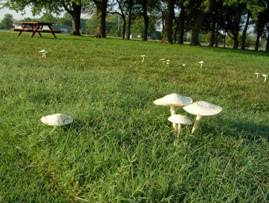
By Jean Field, Pinellas County Extension Horticulturalist
“Eeek! Mushrooms in my lawn…that means fungus. I must kill them. What can I spray them with? There must be something I can use!” These are the questions we get from panic-stricken homeowners right after a heavy rain. Don’t worry; these mushrooms don’t harm the landscape or your lawn. They thrive on moisture and the decomposition of organic matter in soil. If you have mushrooms, your soil is both moist and it contains organic matter…not such a bad situation after all.
Don’t like they way they look? You can remove them by hand or mow them. To prevent them from sprouting, simply reduce the moisture you give to your landscape. Daily rains promote good mushroom growth. If you hand-remove the mushrooms, you will have fewer in the future. Be sure to wear gloves when removing mushrooms and wash your hands well when finished.
Still want to eat home-grown mushrooms? Consider buying a do-it-yourself kit from mail-order suppliers. You can grow shitake, oyster, Portobello and other flavorful mushrooms to satisfy your cooking delights.
Remember, never eat any mushrooms you find in your garden or in the woods. Many poisonous mushrooms in Florida look very similar to the harmless ones.
Don’t like they way they look? You can remove them by hand or mow them. To prevent them from sprouting, simply reduce the moisture you give to your landscape. Daily rains promote good mushroom growth. If you hand-remove the mushrooms, you will have fewer in the future. Be sure to wear gloves when removing mushrooms and wash your hands well when finished.
Still want to eat home-grown mushrooms? Consider buying a do-it-yourself kit from mail-order suppliers. You can grow shitake, oyster, Portobello and other flavorful mushrooms to satisfy your cooking delights.
Remember, never eat any mushrooms you find in your garden or in the woods. Many poisonous mushrooms in Florida look very similar to the harmless ones.
Visit this site for more information:http://edis.ifas.ufl.edu/LH046